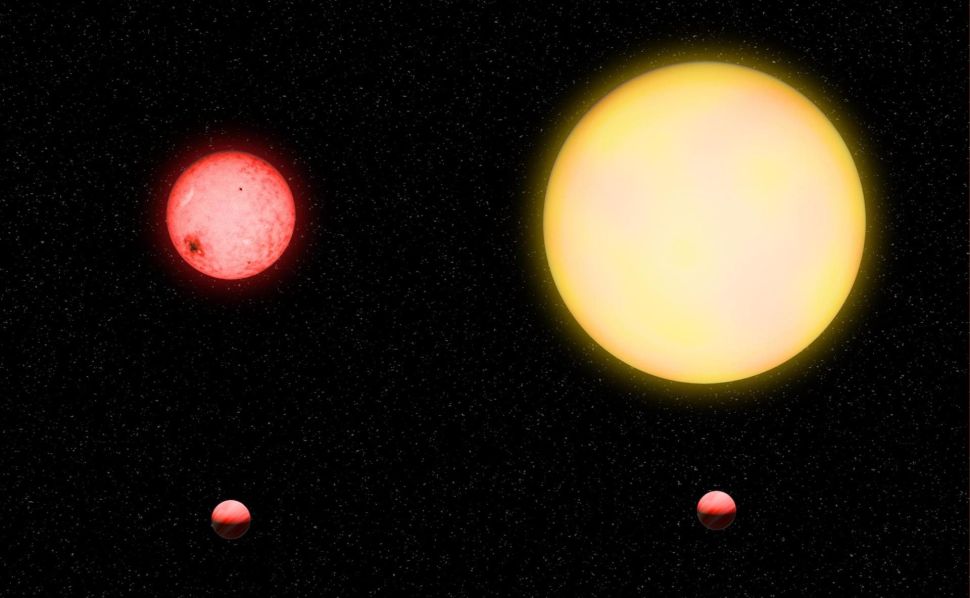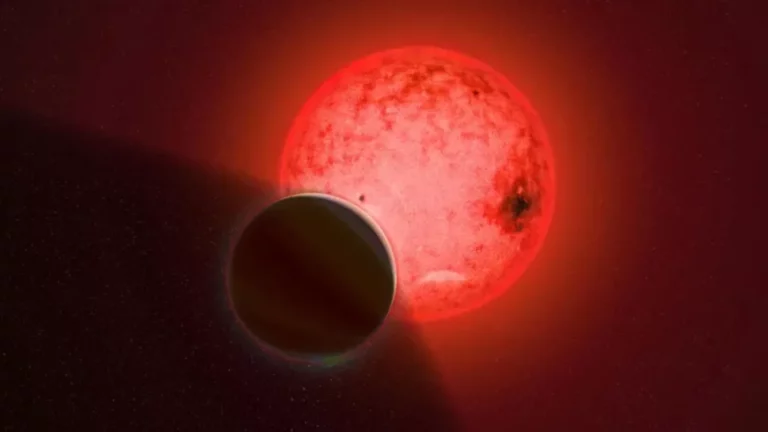A significantly large ‘forbidden planet’ circles an unusually small star that is just four times its size.
A significantly large ‘forbidden planet’ circles an unusually small star that is just four times its size.
Astronomers have made an unusual discovery of a planetary system in which a Jupiter-sized planet orbits a tiny star only four times larger than it. This arrangement, considered “forbidden,” may challenge existing theories of gas giant planet formation.
The exoplanet, named TOI 5205b, orbits a red dwarf star called TOI 5205 that is much cooler and smaller than the sun. M-dwarf stars, the most common type of star in the Milky Way, are typically smaller and cooler than the sun, giving them a reddish color.
While M-dwarf stars have, on average, a higher number of planets orbiting them than other types of stars, it was previously believed that their formation made them unlikely to host gas giant planets. However, the discovery of TOI 5205b by astronomers using NASA’s Transiting Exoplanet Survey Satellite (TESS) telescope challenges this assumption. The planet’s existence was confirmed and studied by the team using a variety of ground-based telescopes and instruments.
“The host star, TOI-5205, is just about four times the size of Jupiter, yet it has somehow managed to form a Jupiter-sized planet, which is quite surprising!” team leader and Carnegie Science astronomer Shubham Kanodia said in a statement.
Despite the previous discovery of gas giants around M-dwarf stars, none of them were found orbiting such a low-mass example of this star class, such as TOI-5205.
Planets are formed within protoplanetary discs – spinning disks of gas and dust that surround young stars. This material is the same matter that created the central star through the process of collapse. When dense patches of the disk collapse under their own gravity, planet cores are formed, which then attract more material.
Current models of planet formation suggest that to create a gas giant, a mass equivalent to ten times that of Earth is required. This first leads to the formation of a rocky core, which subsequently collects gas from the disc to grow into a giant planet. However, this process must occur rapidly.
“In the beginning, if there isn’t enough rocky material in the disk to form the initial core, then one cannot form a gas giant planet. And at the end, if the disk evaporates away before the massive core is formed, then one cannot form a gas giant planet. And yet TOI-5205b formed despite these guardrails,” Kanodia explained in the statement. “Based on our nominal current understanding of planet formation, TOI-5205b should not exist; it is a ‘forbidden’ planet.”
To understand the disparity of this planetary system compared to what astronomers typically anticipate, imagine our sun reduced to the size of a grapefruit. This reduction in size would result in Jupiter, the largest gas giant in our solar system, being about the size of a garden pea.
The TOI-5205 system can be visualized as a pea orbiting a lemon, reflecting the considerable difference in size between the gas giant and the star it orbits.

The size difference is so significant that when TESS employed the transit method – observing the decrease in light caused by the planet passing in front of its star – the dip in light constituted 7% of the star’s total light output.
As a result, the dimming of TOI-5205 caused by this Jupiter-sized exoplanet represents the most substantial known light drop caused by an exoplanet transit.
This extreme dip in light or technically, “large transit depth,” could make the system ideal for follow-up investigations with the James Webb Space Telescope (JWST).
Observations with the JWST could help determine the composition of TOI-5205 b’s atmosphere and may shed light on the processes that birthed this “forbidden” planet.
The team’s research is published in The Astronomical Journal .
Do not forget to share your opinion with us to provide you with the best posts !




0 Comments